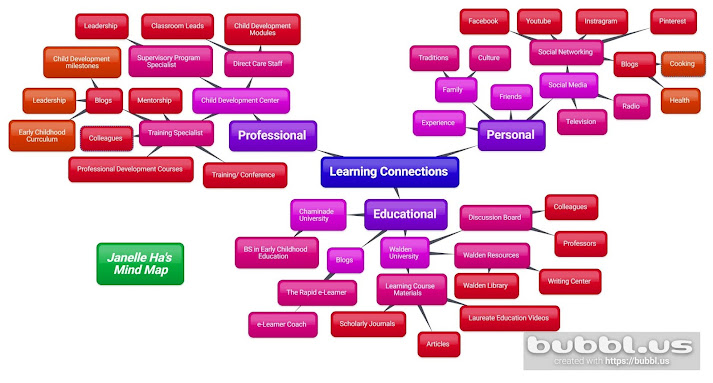Connectivism: Reflection of My Mind Map
Technology has allowed individuals to be active learners who can take the lead on what they want to learn, when they want to learn it, and at their own convenient pace. How I gain new knowledge using the advantages of technology is supported by Connectivism and the premise that people learn by sharing knowledge distributed through technology. As shown through my mind map networks, along with my prior knowledge and experiences from my personal, professional, and educational background, it is consistently changing and adapting to the ever-changing environment.
The world wide web has made it easier, quicker, and more accessible
for me to learn just about everything with current and up-to-date information. The
“Half-life” of knowledge has declined due to the steady stream of information added
to the internet and media (Davis et al., n.d.). Gone are the days when you had
to go to the library to browse through a Magna Carta collection to learn about
history. No longer do you have to purchase abundant of books on any given subject
for the information to become obsolete and sit on your bookshelf while collecting
dust. Information and knowledge can now be stored on the internet and retrieved
later to reference or share with others.
Smartphones and computers have also made all the information
available instantaneously. If a question pops up, I can pull out my smartphone
or computer to find the answer to my question. The learner’s power to continue
learning is more important than the knowledge they already possess (Siemens,
2005). People are not limited to only knowing the information they have gain
through the past, but rather the need and desire to stay informed drives the individuals
to continue to learn through their networks.
A simple question can be answered with the click of a button.
I can render endless inquiries under Google search, YouTube, Pinterest, or
other social networking of any given topic. If I wanted to learn how to cook a specific
dish, I can search the web and get countless recipes, reviews, and ratings from
other users. If I needed to learn technical support to understand how to use a
software, I could watch endless YouTube videos. I can post a question on Reddit
and have an abundance of responses from multiple perspectives, looking at the problem
from various angles and learn from their insight and experience. Social media
has allowed me to stay connected with my friends, family, and coworkers and share
information, resources, and expertise. By tagging and posting articles, videos,
and life experiences, we can learn from one another.
Connectivism has given a new light to the advantages of
gaining knowledge through connections from individuals’ past experiences and
knowledge. As shown on my mind map, everything is intertwined and connected in
various ways. The internet has shown just how easily connected we all are to
one another and how we continue to foster the community of active learners.
Reference:
Davis, C., Edmunds, E., and Kelly-Bateman, Vivian (n.d.).
Connectivism. Emerging perspectives on learning, teaching, and technology. Retrieved
at *Orey_Emergin_Perspectives_Learning.pdf
Siemens, G. (2005). Connectivism: A Learning theory for the
digital age. International Journal of Instructional Design & Distant
Learning, 2(1). Retrieved from Jan05_01 (itdl.org)


Comments
Post a Comment